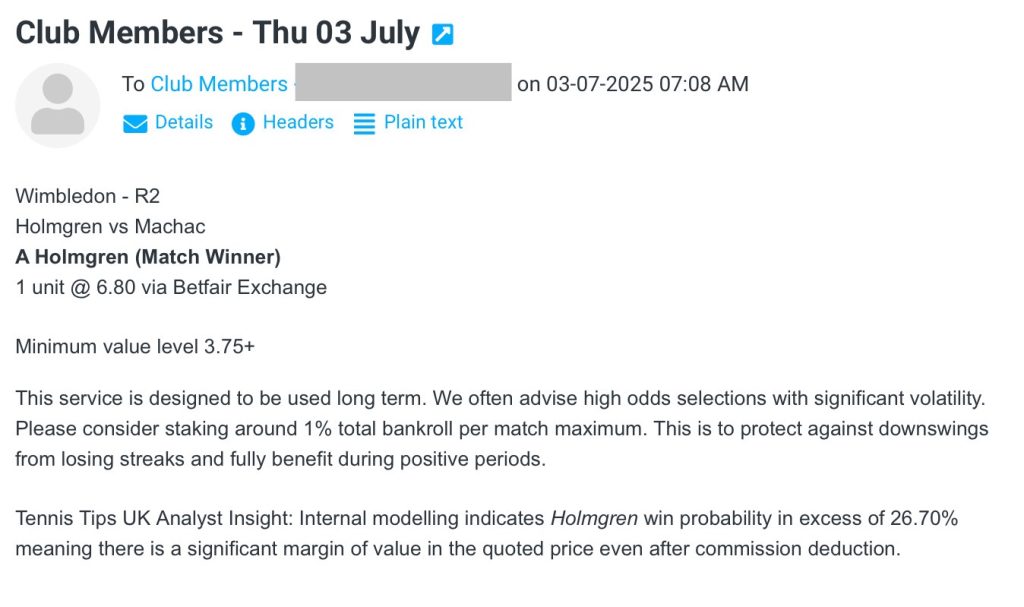| Profit (units) | Yield (%) | Strike Rate (%) | Average Odds (Decimal) | Illustrative Return (£100 staked per pick) |
| +41.80 | 15.20 | 33.10 | 4.45 | £4180 from backing every selection as of July 2025 |
-
✅ WON @ 6.80 (+580) | A Holmgren | Wimbledon R2
£100 stake backing Holmgren to beat Machac returned £568.40 profit… Read more: ✅ WON @ 6.80 (+580) | A Holmgren | Wimbledon R2 -
✅ WON @ 3.35 (+235) – D Evans – ATP Eastbourne
£100 stake backing Evans to beat Paul returned £230.30 profit… Read more: ✅ WON @ 3.35 (+235) – D Evans – ATP Eastbourne -
✅ WON @ 9.20 (+820) – A Bublik – ATP Halle
£100 stake backing Bublik to beat Sinner returned £803.60 profit… Read more: ✅ WON @ 9.20 (+820) – A Bublik – ATP Halle
According to US Sports, Fitness, and Recreation Participation Report released recently, tennis has the biggest participation growth than any other sport. In the period between 2000 and 2012, 31% more tennis players have committed to playing on a long-term basis than before.
It can be concluded that tennis is still by far one of the most popular sports in the world. Its viewership is steady and even sports bettors are loving it for their bonus codes. But, why isn’t it as popular as it was 20, 30 or 40 years ago? Did tennis lose something while it evolved? Are the players as flamboyant as they were in the last decades?
The Boom
The 1970s was the boom for tennis. And although the 80s and the 90s may have contributed to its decline, those decades helped a lot in maintaining it on the same level at which it’s today. And the truth is that the factors that resulted in the 1970s “boom” will not be replicated ever again.
When it was decided in 1968 that professional tennis players could play at any of the four Grand Slam tournaments and make a living playing tennis, the game spurred interest like it never did before or even after that. Tennis no longer had the reputation of an isolated sport discipline practiced only by the rich.
TV Broadcasts
A second very important factor from the “Boom Era” was TV broadcasting. As soon as it was opened to pros, TV stations showed interest in broadcasting tennis events. CBS was the first TV station that started this and was followed by NBC and then the rest.
This way the American public and the world were able to watch all the prestigious tennis events for the first time in their lives. Of course, this also sparked an even greater interest in tennis.
Today, we have internet and free TV, which means we can watch different sports, not just the tennis match that the one of the only two TV stations in the city offers on the program. Choice.
The Rest of the Factors
There were many other factors that contributed for tennis to explode too. Thanks to some of the more distinctive and unique personalities like McEnroe, Nastase, Evert, Billie Jean King, Navratilova and many other, tennis became awesome. They introduced new playing styles and revolutionized the sport like no one.
The level of professionalism was rising too, but the “wild west” situation in the 1970s and early 1980s when the athletes wanted to party and abuse alcohol or drugs, while the officials tried to determine what the professional standards would be for them made the players even more interesting for the press.
Finally, tennis helped the feminist revolution. Female tennis players were recognized as professional athletes so they could earn thousands of dollars for being as athletic as men. Today, this is not a novelty anymore as we are used to seeing professional female athletes in every sport. The conclusion is that the hype has gone, and will never be back like it was in the 1970s.
What is the purpose of club membership?
Most members use the advisory to generate profits via bookmaker and/or exchange accounts. For someone staking £100 per match this has yielded thousands in profit even once the annual membership fee is deducted.
Will bookmakers limit my account(s)?
Most likely, yes. Club bets have a proven track record of value (+ EV) and bookmakers are likely to notice this. Short term you’ll be fine but longer term we suggest using betting exchanges or ‘winners welcome’ bookmakers or brokers. That’s why we always quote and record odds from Betfair Exchange for members as that illustrates profits for those who are limited.
How will it work after joining?
Your membership will be confirmed with a personal welcome email. You’ll get 12 months access from a single payment and there is no auto renewal – we’ll simply ask if you wish to continue after the year has elapsed. You should expect an average of two emails per week detailing the advised selection, match, tournament and odds. Simply login to your betting account and place a wager on the selected market. We only use standard match winner bets, often referred to as the moneyline, so coverage is extensive at virtually all betting portals. Have any questions? Please visit the contact us page. Average response time 24h.
Is club membership limited?
Yes, we allow a maximum of ten members to have an active annual membership at any one time. This is to preserve value and market liquidity. Essentially ensuring it’s practical to obtain the advised odds without them disappearing too quickly.
What bankroll is required?
We suggest £10,000 or more ideally although smaller can work. Most members choose to follow our advice of staking 1% per match. This means it automatically adjusts and scales as the total grows and compounds returns. In the above example; the member would have yielded over £3,000 profit but had to pay the membership fee leaving them with a net profit in excess of £2200. Some members have vastly exceeded this by staking higher amounts but please remember to have a long term focus and ensure capacity for successive losses.
What type of bets should I expect?
Always match winner bets covering men’s professional tennis. This includes ATP events, Challenger and Grand Slams. We specialise in high odds underdogs which have yielded the most considerable profits in extensive back testing. Selections with odds of 10/1 (11.00) are not uncommon. We deliver advisory emails at a consistent time with a minimum of six hours before the scheduled start time to ensure plenty of time to get bets placed.
Who is the club open to?
Everyone with a decent bankroll and a long term outlook. We have members from around the world betting in many different currencies and jurisdictions. Tennis Tips UK are based in the United Kingdom, hence the name, but the club is truly global.
How is profit tracked?
For transparency we operate a public spreadsheet. This shows all key metrics such as units profit, ROI, yield and strike rate. We even monitor the Avg Diff CO % for those statisticians amongst you. In a nutshell this measures the implied value by comparing the advised odds with the sharp closing line. 2% is deducted from all recorded profit figures to simulate exchange commission. Just to clarify bets are only added to the spreadsheet post result confirmation to retain exclusivity of access to paid club members.
For winning bets our team also publish profit reports which feature the original email sent to members for additional tracking and verification purposes. This also includes a rating for that specific prediction which gives an insight into how our strategy is optimised over time.
Who picks the bets for club members?
Tennis Tips UK have grown into a small team over the years. Founded way back in 2013 by an odds compiler at a leading EU bookmaker. Since then joined by a quant and business manager. Each one of us lives and breathes tennis but we like to let our results speak for themselves rather than make outlandish personal claims.
Why don’t you bet on your own picks if they are so good?
We do, frequently. The issue surrounds liquidity and limitations. Club members have access to a wide range of liquidity from global sportsbooks and exchanges. We, as individuals, are far more restricted. Typically though we still stake an average of £10k per week on our selections but unfortunately virtually every bookmaker has long since banned us. We should take it a compliment really as a limitation is an endorsement of the profitability of your bets from an often billion pound institution.
Is there a way to reduce the cost of membership?
The fee is set at a level which allows us to fill membership places. If you are a prospective first time club member enter the promo code ‘TTUK10’ during checkout to reduce the cost. Please note this is a one time discount and not available for returning members.
Since 2013 we have actively built, deployed, maintained and optimised a tennis betting data model. This serves as the foundation of our team’s analysis. We don’t rely on it entirely but it gives a reliable indication as to where the price for a specific player should be. Significant discrepancies between this and actual live market prices across bookmakers and exchanges often flag our attention for further research.
No. When a specific bet is advised our team are stating there is value in the quoted odds. In other words the true probability of that outcome is higher than the implied figure derived from market odds. Long term backing these bets consistently will deliver considerable profit as our results illustrate. However members should be prepared to lose successive bets frequently as the club focuses on significant underdogs.
This is one of the key reasons that the club is only accessible via annual memberships. It was very frustrating to see some join for just a few weeks, lose bets then leave. This benefits nobody. New members should adopt a disciplined bankroll management strategy. The most common is simply staking 1% total bankroll per match. If a handful of consecutive losses would cause terminal bankroll damage then stakes need reducing.
This was a real email sent to club members. It may look a little intimidating initially but the selection in bold is the only essential piece of information to profit. We operate a simple staking strategy of 1 unit = 1% total bankroll. Each email consists of the tournament, match, selection, advised stake, minimum odds and projected win probability. This format will always be followed for consistency. 
Discover more from TENNIS TIPS UK
Subscribe to get the latest posts sent to your email.








